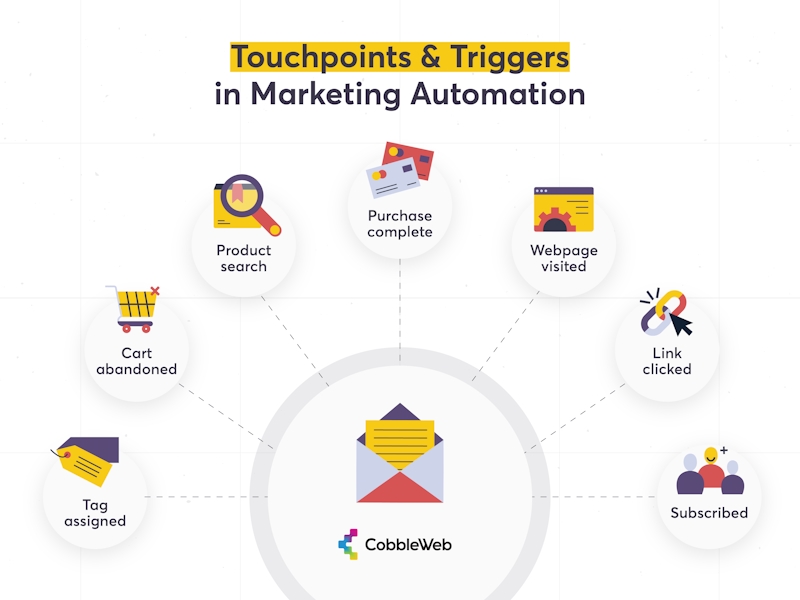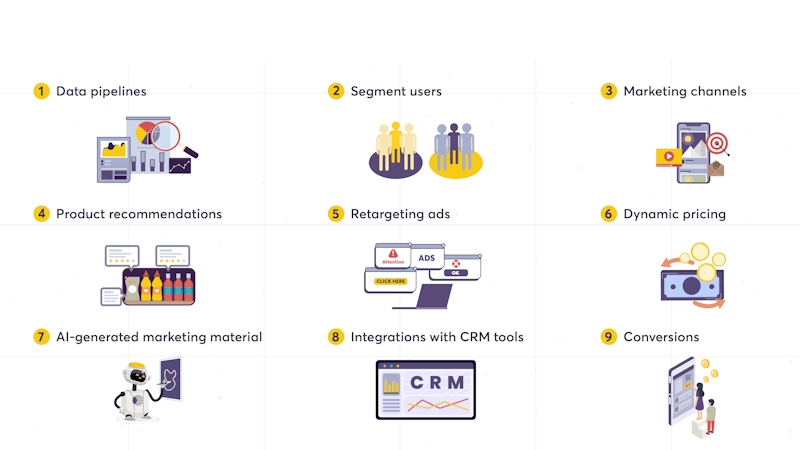Our previous article on marketing strategies for marketplace startups closed with a brief section on scalable tactics. Astute readers may have noticed that most of those growth-focused tactics involve a common, but potentially explosive, element: marketing automation.
It’s no one-trick pony either. Marketplaces are constantly finding new ways to use marketing automation as a growth driver.
- By segmenting users by attributes like demographics, behaviour, or preferences, marketplaces can create highly targeted campaigns that resonate with specific audiences.
- Leveraging user data, marketplaces can offer personalised recommendations for products or services, increasing customer satisfaction and conversion rates.
- Retargeting campaigns allow marketplaces to re-engage with users who have visited their site but haven’t made a purchase.
- Dynamic pricing strategies, such as those used by Airbnb, can optimise pricing based on factors like location, date, and demand, maximising revenue.
But wait, there’s more. Automation not only plays a role in scaling marketing campaigns, but also offers a way to leverage huge or complex datasets, reduces costs, and boosts productivity.
A battlefield analogy
Putting all the moving parts together, though, is not unlike orchestrating a well-planned military campaign!

First comes reconnaissance – quiet, calculated observation. Here, you lay your ear to the ground, gathering data through analytics tools and behavioural tracking. It’s not glamorous but indispensable; the cold statistics are your spies, reporting back on audience demographics, preferences, and those slippery digital footprints. Just as no general attacks without surveying the battlefield, no marketer launches without dissecting traffic patterns and segmenting potential customers.
Next is testing the enemy. This is where A/B testing and small, experimental campaigns enter the fray – an array of skirmishes to probe the market’s defences. Different messaging, different offers, all aimed at revealing where the weak points lie. Some initiatives will falter – casualties in the name of knowledge – but each misstep is a lesson learned. The data pipelines, like scouts in hostile terrain, report back on which messages convert and which audiences engage, feeding actionable insights into your battle plan.
Then comes the full-scale assault. Automation platforms roar to life – email drips fire in synchronised bursts, paid ads flank from multiple channels, and retargeting campaigns press the advantage. The marketing machine, like a modern blitzkrieg, operates 24/7, each system working in tandem to overwhelm the market with precision strikes at scale. Every click, every view, every abandoned cart dragged back into play is part of a larger, unrelenting push for dominance.
Finally, if all goes well, victory is declared. KPIs met, conversions tally up, and the marketplace – tamed and monetised – now submits to your funnel. Yet, as any seasoned general knows, victory is fleeting. Markets evolve, competitors regroup, and what works today may fail tomorrow. So the campaign never truly ends. The data flow continues, the reconnaissance resumes, and the strategist must always remain one step ahead – perpetually refining, retooling, and preparing for the next skirmish, the next opportunity to scale.
If that slightly overwrought intro got you rolling your eyes, we do have some additional ammunition for your marketing automation campaigns.
The role of data and technology in marketing automation for marketplaces
Something that successful marketplaces have in common with a general on the battlefield: they understand the who, where, and what of their targets. By collecting data and analysing user behaviour, they can adjust their marketing messages to their audiences’ needs.
As numerous reports show, shoppers want
“bespoke, personalised interactions with retailers leave them feeling valued.”
However, unless you stick a camera on your users or follow them around, it’s tough to understand what your customers want at scale, let alone develop marketing messages that speak to them.
But there’s a non-creepy solution: harnessing technology to do the job for you. A data pipeline that collects and analyses user data can help you provide the personalised experience your customers want.
Art marketplace, Affordable Art Fair, for example, built a data pipeline with Snowplow Analytics that tracked specific user events They used the collected data to refine buyer personas for better targeted paid advertising campaigns, which led to an increase in user engagement.
Some considerations as you plan your user data strategy:
- Build user trust to collect first-party data: This involves explaining to customers – usually via a privacy policy – why you need the data you’re collecting and how you plan to use it in marketing campaigns and product development.
- Select the right user metrics to track: Whenever you choose a metric, ask yourself if it helps you find, convert and retain loyal customers. The AARRR framework can help you track the right metrics at the different stages of the customer journey.
- Keep data secure and compliant with Data Protection Regulations such as GDPR: How will you store and secure the data once it is collected? Do you have a system in place to manage user data effectively?
Analytics tools to track user behaviour
A data-driven marketing strategy needs analytics software to make sense of data sets. Common analytics tools include:
- Google Analytics: Supports over 50% of the world’s websites today, Google Analytics is free to use and integrates with both Google marketing tools and third-party software.
- Snowplow Analytics: This data collection platform processes and exports behavioural data across your tech stack.
- Segment: Streamlines customer data management and is used by marketplaces like DoorDash and TaskRabbit.
- Amazon Kinesis collects, processes, and analyses video and data streams in real time. Neighbourhood networking app, Nextdoor, uses Kinesis to analyse behavioural data in real time and then prioritise time-critical notifications such as for crime, safety and local events.
Popular marketing automation integrations
Automation software offers a powerful way to scale and manage multiple aspects of your marketing efforts. Most of them support integrations with sales and customer support software, while some are particularly well-suited for ecommerce and marketplaces:
- ActiveCampaign: Offers an omnichannel approach with automated workflows across all marketing channels: email, SMS, landing pages, social media, and chat. It is suited for small businesses and early-stage marketplaces that need to test and grow product-market fit.
- Mailchimp: Initially a basic email marketing tool for small and medium-sized businesses, Mailchimp has added features such as audience segmentation, a customer journey builder, workflow automation and third-party integrations. It occupies 31% of the marketing automation market.
- HubSpot: One of the market leaders in marketing automation and pioneers of inbound marketing, HubSpot holds 23% of the marketing automation market. Their platform primarily caters to marketing teams, but also offers features for sales and customer support teams.
- Salesforce is an integrated customer relationship management platform that offers a uniform view of customers and leads across marketing, sales, and service teams. Automation features include support for bi-directional information flows between Salesforce and a marketplace platform. This can be used to swap lead and onboarding information between platforms.
The difference between marketing and sales automation
While both marketing and sales automation play crucial roles in business growth, they serve distinct purposes.
Marketing automation focuses on automating tasks related to lead generation, nurturing, and conversion. This includes activities like email marketing, social media management, and content marketing.
Sales automation, on the other hand, streamlines the sales process by automating tasks such as lead scoring, appointment scheduling, and contract management.
In the context of an online marketplace, these two disciplines often work in tandem. Marketing automation can generate qualified leads, while sales automation can nurture those leads into paying customers.
Important factors to consider when designing automated campaigns
As our battlefield analogy illustrated, marketing automation strategies should not be implemented willy-nilly. Solid discovery and testing phases will increase your campaign success rates exponentially. That includes aligning campaigns with specific key performance indicators (KPIs) to measure their effectiveness.
A marketplace involves multiple customer personas, and your campaigns must appeal to both demand (buyers) and supply (sellers). Automation should be tailored accordingly.
- For buyers: Focus on personalised product recommendations, price alerts, and abandoned cart recovery.
- For sellers: Automate onboarding, marketplace updates, and promotions to incentivise participation.
Clean, reliable data is the lifeblood of marketing automation. Ensure your data pipeline setup is properly configured to track events, conversions, and user behaviour. If your data streams are broken, your automations will make poor decisions.
Marketplaces thrive on repeat engagement. Map out each stage of the customer and seller journey, automating touch points such as:
- Onboarding: Welcome emails or seller registration sequences.
- Retention: Reactivation campaigns or loyalty incentives.
- Win-back: Personalised offers for churned users.

Automation is powerful, but too much of it can backfire. Over-communicating or spamming can alienate users, and excessive reliance on templates can feel robotic. Balance automated touches with occasional human interaction – like customer service check-ins or personalised seller outreach.
Beware the premature scaling trap. Aggressively scaling customer acquisition through ads or discounts before achieving product-market fit can deplete your cash reserves. If your core metrics (like retention or CAC) aren’t defined properly, this spending will produce vanity metrics rather than sustainable growth.
The future of marketing automation
The future of marketing automation is increasingly tied to artificial intelligence (AI). Amazon, for example, has been experimenting with AI-generated marketing material for sellers, including product descriptions and advertisements.
Advantages of AI automation include improved quality control (checking that marketing materials adhere to quality standards and guidelines, cost reduction (cheaper than hiring marketing agencies), and speed ( generate content much faster than humans).
As AI continues to advance, we can expect to see even more sophisticated marketing automation tools and strategies that will help online marketplaces achieve unprecedented growth.
